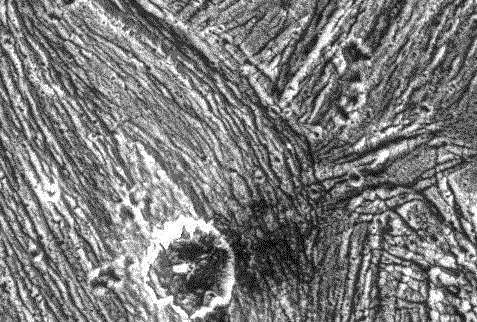Explanation: Ganymede's surface is a wrinkled mess. As large ice-sheets shift on the moon's surface, parts of the surface buckle causing high ridges, deep furrows, and parallel grooves. This photo, taken by the Galileo spacecraft currently orbiting Jupiter, was released yesterday. The large circular feature near the picture bottom is a large impact crater. The impact that caused this large crater also caused the strange dark ejecta seen to the crater's right. The Sun illuminates the scene from the lower left. The Galileo spacecraft has also just discovered that Ganymede has a region of orbiting charged particles called a magnetosphere - a first for any moon. How Ganymede is able to generate a magnetosphere is a mystery.
APOD's Archive of Galileo at Ganymede
1999 2000 2001 2002 2003 2004 2005 2006 2007 2008 2009 2010 2011 2012 2013 2014 2015 2016 2017 2018 2019 2020 2021 2022 2023 2024 2025 |
Yanvar' Fevral' Mart Aprel' Mai Iyun' Iyul' Avgust Sentyabr' Oktyabr' Noyabr' Dekabr' |
NASA Web Site Statements, Warnings, and Disclaimers
NASA Official: Jay Norris. Specific rights apply.
A service of: LHEA at NASA / GSFC
& Michigan Tech. U.
|
Publikacii s klyuchevymi slovami:
gora - dolina - Ganimed - udarnyi krater
Publikacii so slovami: gora - dolina - Ganimed - udarnyi krater | |
Sm. takzhe:
Vse publikacii na tu zhe temu >> | |
